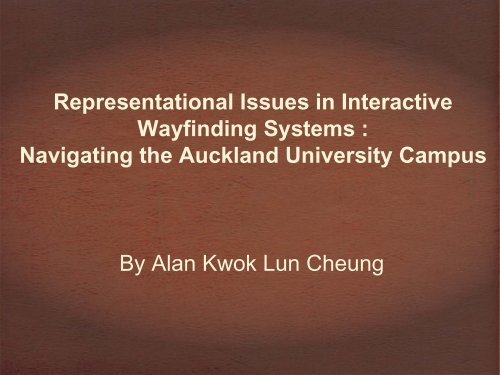Representational Issues in Interactive Wayfinding Systems ...
Representational Issues in Interactive Wayfinding Systems ...
Representational Issues in Interactive Wayfinding Systems ...
- No tags were found...
You also want an ePaper? Increase the reach of your titles
YUMPU automatically turns print PDFs into web optimized ePapers that Google loves.
<strong>Representational</strong> <strong>Issues</strong> <strong>in</strong> <strong>Interactive</strong>Wayf<strong>in</strong>d<strong>in</strong>g <strong>Systems</strong> :Navigat<strong>in</strong>g the Auckland University CampusBy Alan Kwok Lun Cheung
Aim• To explore the effectiveness and pros andcons of different representational options<strong>in</strong> provid<strong>in</strong>g navigational <strong>in</strong>structions• To identify appropriate approaches todesign and implement an <strong>in</strong>teractivesystem for wayf<strong>in</strong>d<strong>in</strong>gujhjnvczsdweqmbza...
Methodology cont<strong>in</strong>ued• Users were divided <strong>in</strong>tothree groups of ten. Eachgroup utilizes onedesignated system.• Users were required totravel four routes byobta<strong>in</strong><strong>in</strong>g <strong>in</strong>structions fromtheir designated system.• Instructions were reduced<strong>in</strong>to its topological form ifpossible
Methodology further cont<strong>in</strong>ued..Changeto Bear<strong>in</strong>g 155!Thenwalkfor 2KM untilyou see theValley!Map-based SystemVerbal SystemImage-based System
Measure of Performance• To identify wayf<strong>in</strong>d<strong>in</strong>g times, a series ofcriteria was produced• Based on where users’ sights are, basedon where the user held the mobile device,based on their body movement, based onverbal comments??• Short stops between waypo<strong>in</strong>ts were nottaken <strong>in</strong>to account
F<strong>in</strong>d<strong>in</strong>gs from Map system• Maps– Delivers most comprehensive spatialconfigurations– Good for judg<strong>in</strong>g distances– Users’ familiarity with maps• Problems :– Difficulty <strong>in</strong> position<strong>in</strong>g oneself– Lack of third dimension– Excessive <strong>in</strong>formation
F<strong>in</strong>d<strong>in</strong>gs from Image system• Annotated images– Delivers spatial configuration <strong>in</strong> a realisticformat– Reta<strong>in</strong>s the flow of the route from waypo<strong>in</strong>t towaypo<strong>in</strong>t• Problems :– Affected by temporal change, weather, etc.– Affected by field and depth of view– Affected by the symbology of the annotations
F<strong>in</strong>d<strong>in</strong>gs from Verbal system• Despite prejudice, verbal system returned bestwayf<strong>in</strong>d<strong>in</strong>g performance– Dimensionless– Visual match<strong>in</strong>g not required– Abstract• Problems :– Language problem– Visual match<strong>in</strong>g not exist– Difficulty <strong>in</strong> communicat<strong>in</strong>g spatial configurations
Other F<strong>in</strong>d<strong>in</strong>gs• People who are unfamiliar with campusenvironment perform similar, and sometimesbetter than people who are familiar with thecampus environment.• Slight changes <strong>in</strong> spatial configuration do notaffect wayf<strong>in</strong>d<strong>in</strong>g performance• Pedestrian flow has some <strong>in</strong>fluence onwayf<strong>in</strong>d<strong>in</strong>g efficiency (not walk<strong>in</strong>g efficiency)• Females tend to notice more landmark changethan males.
<strong>Issues</strong>• Limitation of Mobile Devices• Temporal effect on navigation abilityPlease feel free to ask questions!• Comb<strong>in</strong><strong>in</strong>g all methods <strong>in</strong>to one packageE-mail : ache051@ec.auckland.ac.nzConclusion• No best system for all situations• Non-visual <strong>in</strong>structions can be effective




